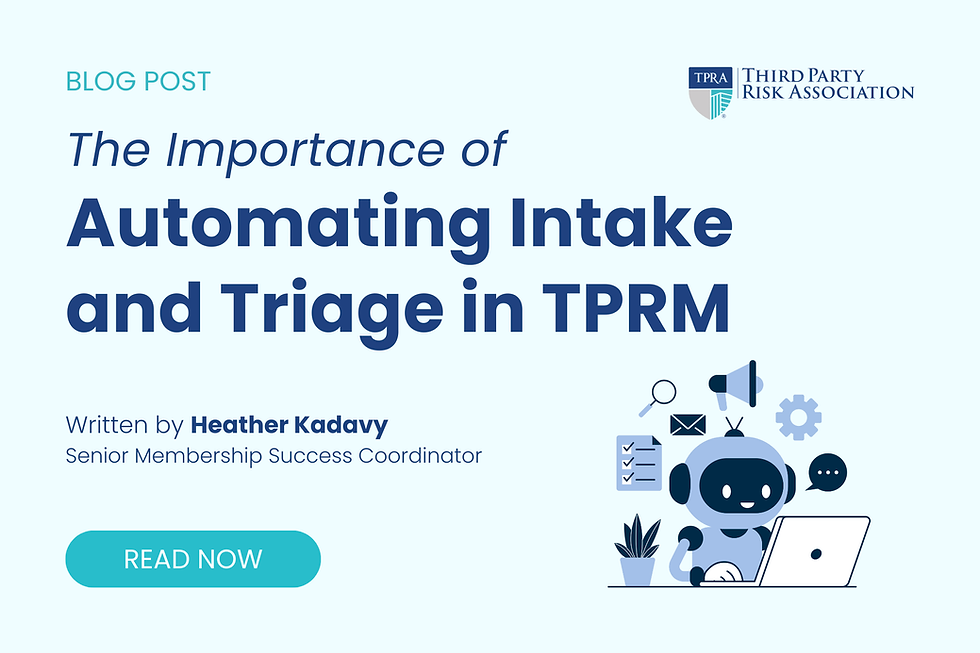From Manual to Modern: How to Spot TPRM Processes Ready for Automation
- Nov 12
- 4 min read

In today’s third party risk management (TPRM) environment, time is a scarce resource, and risk teams are feeling the pressure. As organizations grow their third party ecosystems and regulatory expectations rise, TPRM programs are expected to scale without receiving more people or budget.
That’s where automation can help.
But before jumping into technology solutions, practitioners often ask a crucial question: “How do I know what to automate?”
Not everything is a good candidate. Some processes rely on deep judgment or require hands-on communication. But others, the repetitive, rules-based, time-consuming tasks, are perfect opportunities to automate and free up your team’s time for strategic risk management activities.
Let’s walk through how to spot automation use cases inside your own program, and hear how one risk leader turned hours of manual work into minutes of automated flow.
What Makes a Good Candidate for Automation?
Start with a simple lens. The best automation processes usually have these qualities:
High volume: Happens frequently across many third parties
Repetitive: Same steps followed every time
Rule-based: Decisions based on set criteria or logic
Low variation: Minimal case-by-case customization
Trackable: Easily measurable in terms of success or failure
If you’re doing a task over and over, and it doesn’t require nuanced human decision-making, it’s probably a strong automation candidate.
Common TPRM Automation Use Cases
Here are some of the most common areas where automation delivers real value:
1. Initial Third Party Intake & Risk Tiering
Automating the intake form and feeding third party and business owner responses directly into a tiering model saves time and reduces manual scoring errors. You can set rules to automatically assign low, medium, or high risk based on responses like data sensitivity or criticality.
2. Due Diligence Questionnaire Distribution
Rather than tracking who received what questionnaire; use automation to send the right assessment based on third party type and level of risk, trigger reminder emails, and flag when a response is overdue.
3. Policy & Document Collection
Stop chasing third parties manually for SOC reports, insurance certs, or data mapping. Use tools that auto-request, validate expiration dates, and flag missing documents before you notice.
4. Issue Remediation Workflows
If a third party fails a control assessment, automation can generate a ticket, assign it to the right risk owner, and send periodic follow-ups until it’s resolved or escalated.
5. Continuous Monitoring
Set thresholds and rules so that alerts from external monitoring platforms are filtered, prioritized, and routed to the right business owner and/or third party. Not every continuous monitoring alert needs to land in your inbox.
Real-World Example: Automating Third Party Risk Tiering
Case Study: Financial Services TPRM Team (Mid-Sized U.S. Bank)
A TPRM team supporting over 1,000 third parties struggled to keep up with onboarding. Each third party was manually risk-tiered by reviewing spreadsheets, pasting data into a scoring tool, and then having it double-checked by a second analyst.
“It was taking us 2 to 3 hours per vendor, just to assign a tier,” the risk lead told us.
By implementing an automation workflow using a TPRM platform, they built a rules engine tied to their intake questionnaire. Now, as third parties fill out intake forms, their answers auto-feed into a tiering model based on categories like access to sensitive data, cloud usage, and financial impact. The automation generates a tier instantly, flags high-risk vendors for human review, and logs everything for audit readiness.
Result:
Manual effort dropped from 3 hours to under 10 minutes
Analyst hours saved = ~50/month
More consistent tiering = stronger regulator confidence
How to Identify Automation Opportunities in Your Program
Start simple. Ask yourself and your team:
What process eats up the most time?
Are there tasks we do the same way every time?
Where do errors or delays occur?
What are we manually tracking in Excel or email?
What do we wish we had more time for (but don’t)?
Then, map out the steps. If you can diagram it on paper, chances are you can automate it.
Avoid These Common Pitfalls
Before automating, take these precautions:
Don’t automate a broken process. Fix inefficiencies first.
Avoid black-box logic [a system or algorithm where the internal workings are not easily understood or accessible to the user]. You still need visibility and traceability.
Keep humans in the loop for judgment calls or escalations.
Test in small batches before going wide.
Final Thought: Start Small, Scale Smart
You don’t need a full digital transformation to begin automating. Choose one use case, something your team is tired of doing manually, and experiment. Measure the time saved. Show impact.
Remember in TPRM, every minute you save on manual administration is a minute you can spend mitigating actual risk.
Author Bio

Heather Kadavy
Senior Membership Success Coordinator
Heather Kadavy joined the Third Party Risk Association (TPRA) in 2023 as the Senior Membership Success Coordinator. In recent year(s) Heather has been providing freelance TPRM consulting work to various organizations after retiring from a Nebraska financial institution after nearly 35 years where she oversaw and managed critical programs of the organization including Third Party Risk Management, Information Security,
Physical Security, Safety, Business Recovery, Financial Crimes, Model Risk Management, and Enterprise Risk Management. In her TPRM role she had oversight of over a thousand third party relationships, systems, due diligence reviews and contract management activities. She developed, facilitated, and implemented training programs for thousands of employees over the years.
Heather is a natural born connector of people and values relationship building at the cornerstone of her career. She encourages you to connect with TPRA and herself via LinkedIn to join in the "TPRM Global Conversation".



Comments